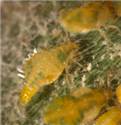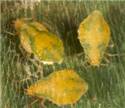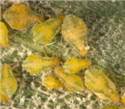Classification
Hormaphidinae: Cerataphidini
Common name(s)
Bamboo leaf aphid
Diagnosis
Colour pale yellow or pale green with transverse diffused streaks of green on abdominal tergite one and in between siphunculi. Head, distal portions of antennae, siphunculi and legs brown, siphunculi sclerotic dark. Antennae 0.22 times as long as body. Processus terminalis shorter than base, 0.22 times as long as the base of the last antennal segment. Ultimate rostral segment as long as ht2, but sometimes little shorter. Siphunculi on dark sclerotic cones, bearing thick 7-9 hairs. Cauda broader than long, bears 6 hairs.
A. bambusae is very similar in external appearance to A. bambucifoliae , but the latter can be easily separated externally by the darker green, uninterrupted longitudinal markings on dorsum. The colonies are found on the undersurface of older leaves on older trees, at the basal portion and attended by ants.
Distribution
Known only from India (Northwest and northeastern regions, Karnataka, Tamil Nadu).
Host plant(s)
Poaceae: Bambusa arundinacea Willd.
Measurements
Aptera: Length of body 1.79, width 1.24; antennae 0.40, segments III: IV: V: 0.04: 0.04: 0.21: (0.09+0.02); u.r.s. 0.08; h.t.2 0.09.
Alata: Length of body 1.80, width 0.94; antennae 0.68, segments III: IV: V: 0.26: 0.12: (0.13+0.02); u.r.s. 0.02; h.t.2 0.09; siphunculus 0.06.
Seasonal occurrence
August-September, December-March
Natural enemies
Coleoptera: Coccinellidae: Anisolemnia dilatata (F.), Synonycha grandis (Thunberg).














